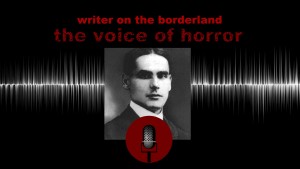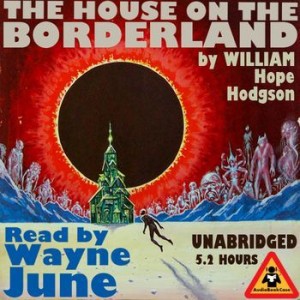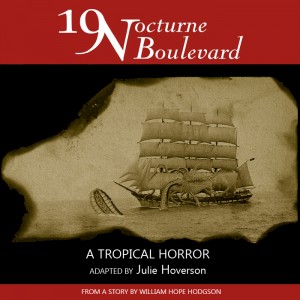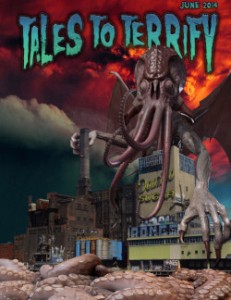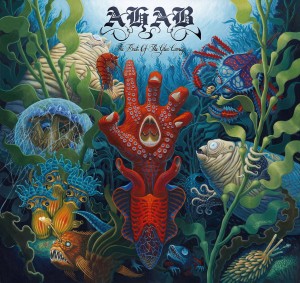Yes, I’ve lost the titles and numbers plot by now. This week’s main feature is a fascinating interview with John C Wright, author of Awake in the Night Land, who gives us detailed insights into WHH’s work and role as part of the pantheon of truly great writers, as well as answering questions on his own fiction. His interview also includes a fine introduction to the concepts of The Night Land itself for those less familiar with the novel. Not to be missed. (Don’t forget that other related posts and interviews in this tribute can be found by checking the William Hope Hodgson tag down at the bottom of the left hand sidebar).
However, greydogtales is an eclectic endeavour, and so by way of easing you in, we start with another link, the trailer for the Japanese film Matango (1963). This is, of course, based on the Hodgson story The Voice in the Night (audio links in The Voice of Horror, posted here a couple of weeks ago and still on tour in parts of the Northwest Territories).
Matango is a tokusatsu or ‘special filming’ production, a special effects approach which really started with the 1954 Godzilla. The end results are either terribly naff or terribly exciting, depending on your taste, temperament and medication. Or the mushrooms you’ve eaten in this case, I suppose.
As this is a Night Land heavy episode, we should also mention an alternative way to enjoy at least some of Hodgson’s stunning end-of-the-world imagery. Personally we think it’s worth ploughing through the whole damn thing, because the good bits stay with you for years, but we understand that the faux-archaic language drags after a while, and the second half is much harder work than the first. So you could have a glance at the adaptation by James Stoddard, the US fantasy author – The Night Land: A Story Retold.
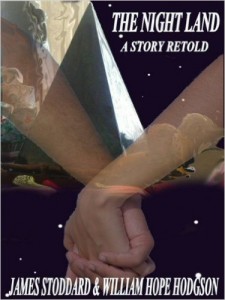 The Night Land: A Story Retold
The Night Land: A Story Retold
Now, we are pleased to welcome author John C Wright who, in addition to producing many other science fiction and fantasy novels, has written four novellas set in the Night Land (see later for more details). For this WHH tribute, he kindly provided us with his views on Hodgson’s writing and Hodgson’s influence on his own work. Rather than pick and choose, we decided in the end to offer the whole interview below.
greydog: Firstly, thank you for joining us! Let’s start with your own experiences of WHH’s writing. Many of us are influenced, even if unconsciously, by the books of our youth. Did you know his work way back, or is he a relatively recent find for you?
Wright: You will perhaps not understand me if I say he is a recent find, but then say I came across William Hope Hodgson decades ago. Let me explain.
You see, every bookish person has a certain small number of books encountered in impressionable youth when the imagination is virgin territory, fresh and unexplored. Books that strike deep into the soul will live in the imagination of that person for the rest of his life. Each is, to him, a book of gold.
For those who have a book of gold living in their imagination since youth onward, every book found thereafter seems a recent find – even if, numbering the years, this new book was found long ago. So it was for me.
This is why even people of exquisite taste will adore books that, had they read them in cynical adulthood, they would little regard or remember. Youth does not seek refinement in expression, but raw wonder, heroism, romance, and ideas that exercise the pinions of the mind. (Science fiction is prone to this more so than most genres: it is, by its nature as a genre of ideas, one not given to cleverness of wordsmithing, or stylistic manners. SF from the pulp days is written in purple prose; SF from the days of Heinlein, Asimov and Clarke is written in unadorned journalistic prose.)
For me, the Books of Gold are those into which I entered in my youth, and their influence on my writing is undisguised: THE DREAM QUEST OF UNKNOWN KADATH by HP Lovecraft, WORLD OF NULL-A by A.E. Van Vogt, EMPHYRIO by Jack Vance, DINOSAUR BEACH by Keith Laumer. It was from THE TIME MACHINE by HG Wells I understood the concept of ‘Deep Time’ and from LAST AND FIRST MEN by Olaf Stapledon I saw how ‘Deep Time’ stood in comparison to human history and human evolution. Nearly everything I have written is some offspring or miscegenation of one or more of these seminal books.
Now I had reached an age when the wonder of youth was past me, or so I thought. It happened that I was writing a Lovecraftian pastiche called NIGH-FORGOTTEN SUN, about a world whose sun has died and is being kept alive in the eternal night by magic. A friend of mine thought I had based my idea on a book by Hodgson called THE NIGHT LAND. I answered that I had never heard of this book. Not knowing how momentous it would prove, he gave me his copy.
I cracked the pages, and was startled and rapt. At the first mention of the Towers of Sleep or the Giant’s Tomb – phrases never explained, but redolent with the wild perfume of otherworldy and unearthly glamor – that I knew I had found the lost wonder of youth again. Then, the tragic death of the hero’s true love, his sorrow, and he is visited by dreams of his next incarnation, countless cycles of time into the future, in a land as strange to us as we would be to antediluvians.
The world had died countless aeons ago, and in the midst of a land that has never seen the sun, a seven mile high pyramid of imperishable metal rises, besieged and surrounded by nonhuman horrors, slow as glaciers, terrible as raging wolves, gigantic, or silent and shrouded like hooded ghosts… For reasons never mentioned, it is better to meet these nameless entities with immediate suicide than to fall alive into their power.
And, here and there scattered about the darkened and terror-haunted landscape were remnants from elder aeons long forgotten, such as the heavier-than-air flying machines dating from years when the air had once been thick enough to support their wings. (This is a startling conceit for a manuscript published in 1912 and written years earlier. By way of comparison, the iPhone is as old at the time of this writing as the Wright Flyer was to Hodgson’s publication.) The author casually credits our remote ancestors with superb inventions issuing from a different understanding of the order of nature, things like the Earth Current or living disk-weapons or telepathic spyglasses, or Doors that open into other realms of being, whose origins are as obscure to them as the inventor of the fire-drill or hand-ax is to us. The sheer magnitude of edifice, of time-scales, and above all the hopeless magnitude of evil, was staggering to me, and still is.
To maintain an aura of hushed and malignant horror across the space of a short story would have been an impressive artistic achievement: to do so across nearly two hundred thousand words is an unparalleled prodigy. Moreover, to make this work of the macabre into a paean praising the undying power of love shows a magnificence of spirit, a boldness, I have seen in no other writer in the genre of dark fantasy. Boldly, Hodgson makes his theme the utmost opposite of his mood.
And, again, Hodgson does something I have seen a few other writers following in his footsteps, namely Jack Vance and Gene Wolfe, attempt: to treat the props and settings of science fiction with the mood, theme and glamor of fairyland, so that what might be far-future science or far-distant extraterrestrials are depicted as mystical or unearthly powers and spirits. It is a world where the boundaries between the spiritual and material was blurred. Hodgson invented his own genre: the science-fantasy.
It was a book of gold to me, the first such I had read since childhood. It was childhood dreams, and perhaps nightmares, come again. But I only had the first half of the book.
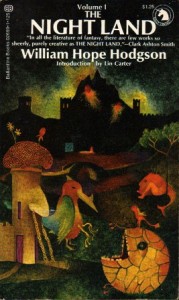
What my friend gave me was the Ballantine paperback, the Adult Fantasy series, edited by Lin Carter. I understand Mr. Carter cut out some of the purple passages that annoyed other readers: all I can say is that I was not annoyed. But he also cut the book in two, so that, for years, this haunting book was doubly haunting, because it was as unfinished as Plato’s TIMEAUS. The volume ends at the spot where the nameless narrator stands looking down at the blasted and darkened Lesser Redoubt, and feels the malign spirits dwelling in those now desecrated and darkened halls, and every evidence is that his beloved, Mirdath the Beautiful, despite having found her again after millions of years of endless reincarnations, is lost.
In those days I was a penniless student, nor was there an internet where public domain books could be read free of charge, nor purchased from obscure booksellers across country. I was not to read the second half of the adventure for years – nor was this necessarily a bad thing, since the second half of the book is, in my opinion, weaker than the first, all save the final chapter, descending into sentiment and silliness in places. So the fact that my imagination was unfed – what is more of a torment to the imagination than an unfinished tale? – may have indeed increased my admiration of his book.
I ran a role playing game with my friends in law school set partly in the world of Roger Zelazny’s JACK OF SHADOWS and partly in the Night Land of William Hope Hodgson. Because of this, I had to invent many details of background which might come on stage in a game the authors needed not to fret over, and so I had a thick folder of material, settings and characters and so on, of Night Land material.
Unlike someone who sets a game in a Tolkienesque background, there are not that many writers with a thick folder of material set in a Hodgsonesque background. I dare say I had pondered and dreamed more about the Last Redoubt, and wrote down more, than anyone of my generation. But when law school was over, my friends and I graduated, and the game ended, I put the folder away, perhaps a little sad that so much work would never be used again.
Ah, but then I found out that Andy Robertson was seeking stories set in that background, and I felt the invisible brush of the wings of destiny. Here was the story I was born to tell. The result you know: AWAKE IN THE NIGHT is my homage to Hodgson, and my memorial to Andy Robertson. May he rest in peace.
greydog: And why do you think The Night Land holds such fascination for writers, over one hundred years later, when so many other Victorian and Edwardian fantasies have been forgotten?
Wright: There are several reasons: first, it is merely because The Night Land is one of the most imaginative settings in all literature. Had Hodgson not attempted to write in a fatuous prose style of faux archaism (an unfortunate blunder) I dare say this book would be as well regarded as any offering by Poe. Second is the timelessness. By setting the tale so unthinkably far in the future, the author neatly avoids any anachronisms stories set, for example, in the futuristic year of 1984 might suffer when that year comes and goes.
Much ink has been spilled over the question of what defines science fiction, or what the first truly science fictional book is. I will not revisit that quarrel here, but I will mention that one strong contender for the honor of first science fiction tale is HG Well’s THE TIME MACHINE, and for this reason: it has one element earlier writings do not have, not his own nor those of Jules Verne nor Mary Shelly. That element is a sense of Deep Time, that is, a sense of time on a geologic rather than a Biblical scale. This sense of Deep Time is one of the hallmarks of the scientific revolution which severs the modern generations from the worldview of our forefathers. It is as dramatic a dethronement of the centrality of man as the heliocentric revolution of Copernicus. But Wells’ THE TIME MACHINE (1895) was published only 17 years before Hodgson’s THE NIGHT LAND (1912). (By way of comparison, that is the same span as separates the second Harry Potter book or the second Song of Ice and Fire book from the time of this writing.)
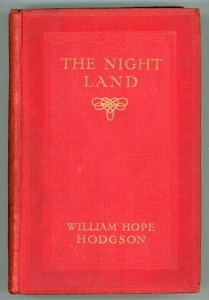
If I may betray my partisan loyalty for a moment, I would say frankly that THE NIGHT LAND has aged better than THE TIME MACHINE, since the peevish Victorian fretting over the injustice of the English class system that underpins the ironic point of Wells’ work is a quaint artifact of a bygone age, whereas the simple and mythic theme of a man facing a cosmos of hellish darkness and emptiness to find his true love once again, even beyond the doors of death, is a theme than cannot age.
So Hodgson’s work is timeless in two senses: he has selected a theme that, like springtide, is ancient and yet fresh; and he has worked out a mood, props and setting that is heavily laden with a hoary and archaic savor, but it is an archaism not of an unimaginably ancient past but rather (if I may be permitted a paradox) an archaism one of an unimaginably ancient future.
Third is the striking symbolism. The Last Redoubt is an unconquered but doomed citadel at whose downfall all human life (and, indeed all non-abhorrent life forms of earth) will be extinguished, and the House of Silence reign supreme forever over a world of peering things, giants, living mountains, night-hounds, glowing pits, ice floes, and sleepless watchers.
Each man’s soul stands in this same relationship to all the evils of this sad world: that he will most certainly die is the one bit of knowledge no man can escape. But that the powers of darkness, before that hour, can be kept at bay provided only that they are not invited in. And, again, love is the only thing worth venturing out of your own soul to seek, despite the spiritual and physical dangers. And this is merely only of many symbolic parallels one might see in this striking and appalling image. Any beloved thing threatened is, in its own way, a Last Redoubt.
greydog: One of the trademarks of your own Night Land stories is your integration of classical Greek influences. How did bringing that in come to mind?
Wright: Hodgson introduces only a single word from the post-historical language of his far future world: the weapon of the hero is called a diskos, which is Greek. I wanted to obtain the same mood of far-removed remoteness in time as Hodgson, and thought names from myth would carry the necessary sense of time.
The only names given in the tale are Naani and Aschoff, so I might have used Dravidian or Russian names for the same purpose, but I wanted to name one character Perithoos, after the man that Theseus abandoned alive in Hell.
greydog: You mentioned Jack Vance above, and I have often wondered if he was acquainted with The Night Land. Do you find that aspects of Vance’s Dying Earth series resonate with you as a writer?
Wright: I will answer this by mentioning my short story, ‘Guyal the Curator’ had the distinct honor of appearing in the homage anthology SONGS OF THE DYING EARTH edited by George R. R. Martin and Gardner Dozois.
Greydog: I understand that you are also familiar with Hodgson’s The House on the Borderland. What, as a reader, strikes you most about that particular book?
Wright: I say again that Hodgson had the honor of having founded his own genre, that of the gothic and anachronistic science fantasy, a genre Jack Vance and Gene Wolfe have also explored. Well, in this story, Hodgson created a niche or sub-genre which was later explored to much greater extent by HP Lovecraft. Now, to be sure, writers before and since have written gothics, macabre stories, weird tales, and dark fantasies. But what Lovecraft did in the main body of his published work, and what Hodgson did here, is capture a sense of scientific horror. I do not mean the horrors created by a misuse of science.
I mean the sense of desolation and inhumanity impressed on the imagination of man by the magnitude of the modern view of the physical universe. The modern Einsteinian discoveries of a vast universe with no special center, where time and space are subject to warps and distortions, where the Hubble expansion and the heat death of the universe promises us that the cosmos will one day be eaten to nothing by entropy, and all life cease with no possibility of emerging ever again – all these things deeply impress the human psyche with a sense of appalling isolation and nihilism. Compared to the sheer inhumanity of Cthulhu of Lovecraft, or the dark gods seen by the recluse in House on the Borderland, something like a ghost or a werewolf or a vampire – all things that had once been human – or a devil from hell – a thing that had once been an angel – is warm and comforting by contrast.
greydog: And finally, might we be seeing more Night Land stories from you in the future, or is that chapter closed for now?
Wright: At present, I have no plan to revisit the Night Lands, no inspirations, no stories left to tell in that setting. As for the future, all these things are in the laps of the muses.
greydog: Many thanks again. John C Wright’s most recent fiction includes the Count to the Eschaton Sequence. Architect of Aeons is the fourth and latest volume in that sequence.
His Night Land novellas are Awake in the Night, The Cry of the Night Hound, Silence of the Night (originally published on the late Andy Robertson’s website – see previous greydog post for The Night Land website update), and The Last of All Suns. All four novellas are now available in one volume from Castalia House, Awake in the Night Land:
What is there left to say about WHH? Er, well, we haven’t actually given enough coverage to House on the Borderland, the Captain Gault tales, his poetry, his sea horror stories…. it’s all gone horribly wrong. So next week we will try to slam in as much as we possibly can. Sorry, I mean that we’ll offer a range of carefully considered and finely crafted articles to extend your WHH enjoyment for as long as possible. More links, curious articles by James Bojaciuk, and an interview with writer and editor Sam Gafford who, unlike me, actually knows serious stuff about William Hope Hodgson…

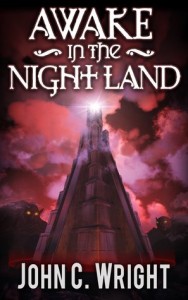 Awake in the Night Land
Awake in the Night Land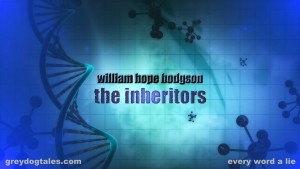

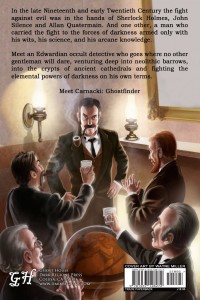
 No-472 Cheyne Walk (e-book)
No-472 Cheyne Walk (e-book)
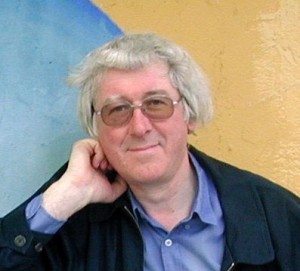
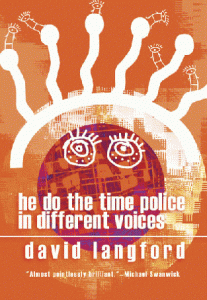 He Do the Time Police in Different Voices
He Do the Time Police in Different Voices